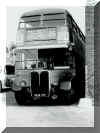 London Transport RT251, Registration HLW238, with PRV Bodywork new in
1948, this bus was exported to Ceylon (Sri Lanka) in 1958.
London Transport RT251, Registration HLW238, with PRV Bodywork new in
1948, this bus was exported to Ceylon (Sri Lanka) in 1958.The RT bus (sensibly the London Transport version of the standard AEC Regent III product), had a 16ft 4in wheel-base, 6 cylinder 9.6 litre engine with transmission through a four speed air operated pre-selective gearbox with fluid flywheel. Post war, London Transport de-rated the RTs 115 horse power diesel engines by up to 15% to ensure a longer life (this preface by Dean Jones).
RT 1906 can be found here detailed in the Export Brochure.
 London Transport RT251, Registration HLW238, with PRV Bodywork new in
1948, this bus was exported to Ceylon (Sri Lanka) in 1958.
London Transport RT251, Registration HLW238, with PRV Bodywork new in
1948, this bus was exported to Ceylon (Sri Lanka) in 1958.
 London Transport RT885, Registration JXN263, with PRV
3RT3/1 Bodywork pictured pre-delivery in October 1948.
London Transport RT885, Registration JXN263, with PRV
3RT3/1 Bodywork pictured pre-delivery in October 1948.






 Registration KYY685 Fleet No. RT1830 Built July 1950 with PRV Body 3RT8
Registration KYY685 Fleet No. RT1830 Built July 1950 with PRV Body 3RT8
 London Transport RT4582, Registration NLP575, with PRV
RT8/2 Bodywork new in November 1960.
London Transport RT4582, Registration NLP575, with PRV
RT8/2 Bodywork new in November 1960.
 London Transport RT4325,
Registration NLE989,
with PRV RT3(c) Bodywork is shown here at the Weymouth Rally in 1975.
London Transport RT4325,
Registration NLE989,
with PRV RT3(c) Bodywork is shown here at the Weymouth Rally in 1975.
 Dean Jones, who kindly supplied this photograph of HLW 177, is keen
to find a ¾ inch to foot scale
“general arrangement drawing” of an RT3 'like the one pictured here in July '05 at the Finchley Carnival.
Can you help? Please contact me if you can and I'll pass the message on.
Dean Jones, who kindly supplied this photograph of HLW 177, is keen
to find a ¾ inch to foot scale
“general arrangement drawing” of an RT3 'like the one pictured here in July '05 at the Finchley Carnival.
Can you help? Please contact me if you can and I'll pass the message on.
 Now a teaser! Spot
the difference! Chris Stanley supplied this image of HLW 177 pictured at West Ham garage
around 1968/9.
Now a teaser! Spot
the difference! Chris Stanley supplied this image of HLW 177 pictured at West Ham garage
around 1968/9.
Yes they are both HLW 177 but they sure are different! Why? Well Park Royal began production of the RT3 during 1946 and this particular bus, LT's RT190 - HLW 177, has a very unusual history.
Please click here to find out more.
And now a lesson in roof removal techniques employed at PRV:
In the summer of 1948 a brand new bus off the production line was driven out of the Park Royal Vehicles, Abbey Road plant. It was one of a batch in its pristine glory (this theory is supported by the PRV advertisement attached to the nearside rear window) en-route to service with London Transport.
It's route should have been along Abbey Road, across the Grand Union Canal to the junction with the North Circular Road. But instead it took a left into Twyford Abbey Road and should have turned right into any one of the other three roads that, at the time, joined the North Circular - it didn't! Continuing along Twyford Abbey Road it encountered the Piccadilly Line railway bridge. The bridge won!
The event made the front page of the London Evening News and the photograph is copyright of Associated Newspapers Ltd., Northcliffe House, London. I reproduce it here in the trust that no one will take issue as this is for nostalgic reasons and not for commercial gain.
The photograph was taken outside number 38 Twyford Abbey Road and was kindly sent to me by Patricia Larbalestier who now lives in Vancouver. She is the little girl in the light blazer between the boy and the older girl.
I can bet there were some red faces at PRV. And how fortunate the bus was on an inaugural run with no passengers. I would not wish to consider the otherwise consequences.
Dave Kriesler has advised me: In Ken Blacker's book 'RT - the story of a London Bus' (Capital Transport, 1979 - ISBN 0 904711 18 8), on page 82 appears a ¾ nearside photo, taken inside the grounds of PRV's works, of RT682 (registration JXC45), minus its roof, with the caption: "Even before reaching London Transport, Park Royal bodied RT682 was de-roofed, an event which delayed its entry into service by six weeks. The strength of the upper deck framework was such that no distortion to the window pillars or cantrail is visible despite the severity with which the roof was torn off". The repaired RT682 eventually went into service at Holloway (J) garage in July 48.
If anyone can shed more light on what this unfortunate bus is, please let me know.